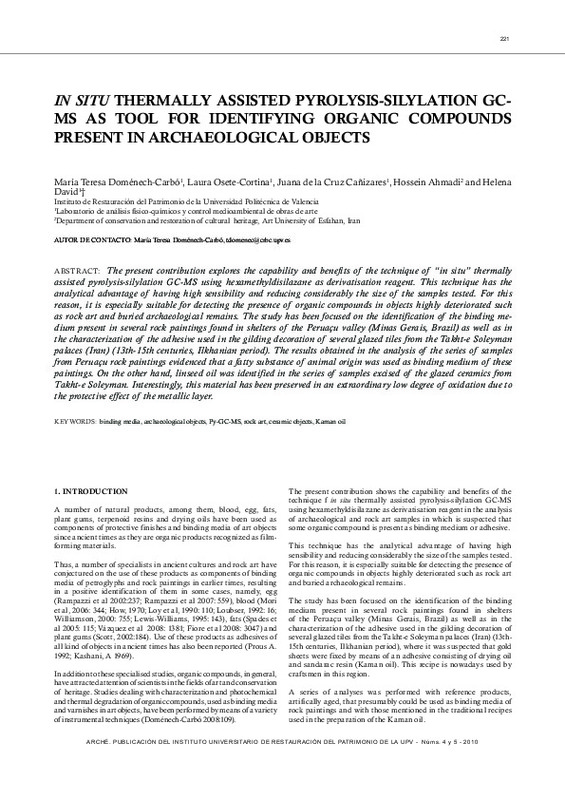JavaScript is disabled for your browser. Some features of this site may not work without it.
Buscar en RiuNet
Listar
Mi cuenta
Estadísticas
Ayuda RiuNet
Admin. UPV
In situ thermally assisted pyrolysis-siIylation GCMS as tool for identifying organic compounds present in archaeological objects
Mostrar el registro sencillo del ítem
Ficheros en el ítem
| dc.contributor.author | Domenech Carbo, Mª Teresa
|
es_ES |
| dc.contributor.author | Osete Cortina, Laura
|
es_ES |
| dc.contributor.author | De la Cruz Cañizares, Juana
|
es_ES |
| dc.contributor.author | Ahmadi, Hossein
|
es_ES |
| dc.contributor.author | David, Helena
|
es_ES |
| dc.date.accessioned | 2013-07-12T08:59:16Z | |
| dc.date.available | 2013-07-12T08:59:16Z | |
| dc.date.issued | 2010 | |
| dc.identifier.issn | 1887-3960 | |
| dc.identifier.uri | http://hdl.handle.net/10251/31075 | |
| dc.description.abstract | The present contribution explores the capability and benefits of the technique of ¿in situ¿ thermally assisted pyrolysis-silylation GC-MS using hexamethyldisilazane as derivatisation reagent. This technique has the analytical advantage of having high sensibility and reducing considerably the size of the samples tested. For this reason, it is especially suitable for detecting the presence of organic compounds in objects highly deteriorated such as rock art and buried archaeological remains. The study has been focused on the identification of the binding médium present in several rock paintings found in shelters of the Peruaçu valley (Minas Gerais, Brazil) as well as in the characterization of the adhesive used in the gilding decoration of several glazed tiles from the Takht-e Soleyman palaces (Iran) (13th-15th centuries, Ilkhanian period). The results obtained in the analysis of the series of samples from Peruaçu rock paintings evidenced that a fatty substance of animal origin was used as binding medium of these paintings. On the other hand, linseed oil was identified in the series of samples excised of the glazed ceramics from Takht-e Soleyman. Interestingly, this material has been preserved in an extraordinary low degree of oxidation due to the protective effect of the metallic layer. | es_ES |
| dc.description.abstract | El presente trabajo explora la capacidad y ventajas que aporta la Pirólisis-sililación GC-MS empleando HMDS como reactivo derivatizante. Esta técnica presenta la ventaja de su elevada sensibilidad y la considerable reducción del tamaño de muestra que se require para el análisis. Por este motivo, es especialmente adecuada para la detección de compuestos orgánicos en objetos que se encuentran en un avanzado estado de deterioro tal y como es el caso del arte rupestre y los restos arqueológicos. El estudio se centra en la identificación del aglutinante presente en diferentes pinturas ruprestres encontradas en los abrigos del Valle de Peruaçu (minas Gerais, Brasil) así como la caracterización del adhesivo empleado en la decoración con lámina de oro de varios azulejos vidriados procedentes de los palacios de Takht-e Soleyman (Iran) (siglos XIII-XV, periodo Iljanato). Los resultados obtenidos en el análisis de las muestras de las pinturas rupestres de Peruaçu evidencian que se empleó una sustancia lipídica de origen animal como aglutinante de la pintura. Por otro lado, en las muestras extraídas de los azulejos de Takht-e Soleyman se identificó aceite de linaza. Destacar, que este material se ha conservado en un estado de oxidación extraordinariamente bajo debido al efecto protectivo de la lamina de oro. | es_ES |
| dc.format.extent | 6 | es_ES |
| dc.language | Inglés | es_ES |
| dc.publisher | Instituto Universitario de Restauración del Patrimonio de la UPV | es_ES |
| dc.relation.ispartof | Arché | es_ES |
| dc.rights | Reserva de todos los derechos | es_ES |
| dc.subject | Binding media | es_ES |
| dc.subject | Archaeological objects | es_ES |
| dc.subject | Py-GC-MS | es_ES |
| dc.subject | Rock art | es_ES |
| dc.subject | Ceramic objects | es_ES |
| dc.subject | Kaman oil | es_ES |
| dc.subject | Aglutinante | es_ES |
| dc.subject | Objetos arqueológicos | es_ES |
| dc.subject | Arte rupestre | es_ES |
| dc.subject | Objetos cerámicos | es_ES |
| dc.subject | Aceite de Kaman | es_ES |
| dc.subject.classification | CONSERVACION Y RESTAURACION DE BIENES CULTURALES (UPV) | es_ES |
| dc.title | In situ thermally assisted pyrolysis-siIylation GCMS as tool for identifying organic compounds present in archaeological objects | es_ES |
| dc.title.alternative | Pirólisis-sililación "in situ" (Py-Gc-Ms) como técnica para la identificación de compuestos orgánicos presentes en objetos arqueológicos | es_ES |
| dc.type | Artículo | es_ES |
| dc.rights.accessRights | Abierto | es_ES |
| dc.contributor.affiliation | Universitat Politècnica de València. Instituto Universitario de Restauración del Patrimonio - Institut Universitari de Restauració del Patrimoni | es_ES |
| dc.description.bibliographicCitation | Domenech Carbo, MT.; Osete Cortina, L.; De La Cruz Cañizares, J.; Ahmadi, H.; David, H. (2010). In situ thermally assisted pyrolysis-siIylation GCMS as tool for identifying organic compounds present in archaeological objects. Arché. (4-5):221-226. http://hdl.handle.net/10251/31075 | es_ES |
| dc.description.upvformatpinicio | 221 | es_ES |
| dc.description.upvformatpfin | 226 | es_ES |
| dc.description.issue | 4-5 | |
| dc.identifier.eissn | 2445-1150 |






